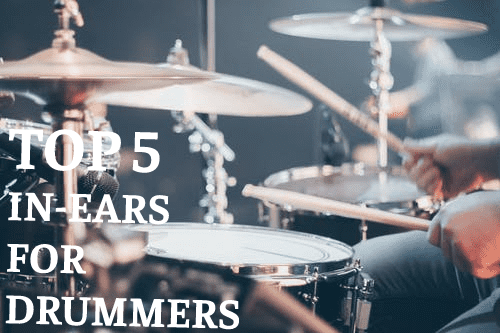Hello, and welcome to the list of Top 5 In-Ears for Drummers.
In a way, we are looking for in-ears that leave the signal relatively untouched by running it through the headphones themselves. That being said, we still want ones with control the signal. Confusing right? To be more specific, we are looking for:
- In-ears with a decently wide soundstage. If the drums all came from the center, they’d end up on top of each other, cluttered and hard to distinguish. For clarity’s sake and simply better sound, drumkits are mixed with each piece panned in certain positions. A wide soundstage would accentuate this, as well as whatever accompaniment the drummer may need to hear for timing and cue reference. At the same time, too wide a soundstage could be distracting, but that’s where personal preference comes in.
- Ones that are somewhat limited in their sub-bass response, for over periods of time our ears become less sensitive to lower frequencies, degrading one’s hearing more and more over time. This applies greatly to drummers, who literally sit in the driver’s seat of the bass drum. At the same time, we want good representation in the lows, but rather from the primary body of the kick itself, which sits more in the low-mid range. It helps to be able to hear what you’re playing, and with this degrading sensitivity, it’ll come in handy to use other frequencies to identify it.
- We want a neutral mid-range that does its job in defining each piece of the kit, as to provide the drummer with equal representation of every piece across the set. Too much would not only affect the drum signal, but other facets of a mix that may be essential to playing, ie vocals or guitar or bass, would become jumbled and lose clarity. Too little, and the pieces lose their definition. All we are looking for is clarity and accuracy from the whole, so a flat, neutral mid-range response is the ideal choice.
- We also want the highs to be clear and controlled, for the constant clash of cymbals can easily fatigue, even damage one’s ears. Luckily, most in-ears have high-end roll-off to deal with this, but the characteristics of the headphones themselves will obviously vary. We need all of these things, along with accuracy, because as mentioned before, drummers need to be able to hear not only themselves, but the other instruments as well (to an extent). These other instruments are defined primarily in the mid-high range, making it essential that they are concise and well-representative throughout the playing.
All around we are looking for a signal leaning towards flatness – a more involved in-ear would distract from the goal, and that is to play drums at the very best of your ability. A flat-sounding headphone allows one to get everything that they need in the most accurate way without adding any color or body that could make things hard to hear clearly, and even further, make your job harder.
In terms of wear, it is necessary to have IEMs that provide comfort as well as durability. If you’re familiar with IEMs in this regard, you know that the wires are easily damaged due to the physicality in playing the instrument, so it may also be a good idea to get ones with replaceable components. Luckily, nearly all of the top companies have these available, but it’s good to make sure you’re not spending more than you have to.
As you can see, there are a lot of factors to consider when buying a pair of in-ears for drumming, though the verdict lands on your preference. It begs the question – which pair would best suit my needs and tastes? That’s why we decided to compile a list of the top five drumming in-ears. Let’s take a look.
I will note that we will be judging these based off of the following factors:
- Comfort and Durability
- Soundstage, Lows, Mids, and Highs
- Replaceable components
FINAL AUDIO B2
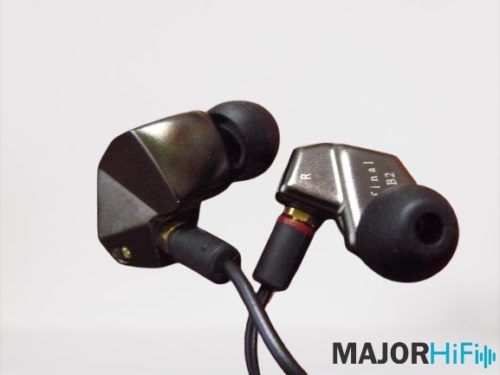
Comfort – Fits snug in the ear – though a heavier shell, they didn’t pop out.
Durability – Metal shells keep the earphones safe, while the wire is honestly average as far as durability is concerned.
Soundstage – A nice width, not too spacious, but not too thin. Keeps it focused very well.
Lows – Good balance – doesn’t have the best body, but holds its place very well. With a constant kick drum going, this could be useful.
Mids – Pretty flat, no jumble or milk. Does its thing, not too noticeable.
Highs – Quick, solid response. Snappy, but not distracting or overpowering.
Replaceable components – Yes, but pricey
When I plugged in and hit play, I knew right off the bat that these are great for this application. You get the bare bones of the music, which in this case, is perfect.
SHURE SE535
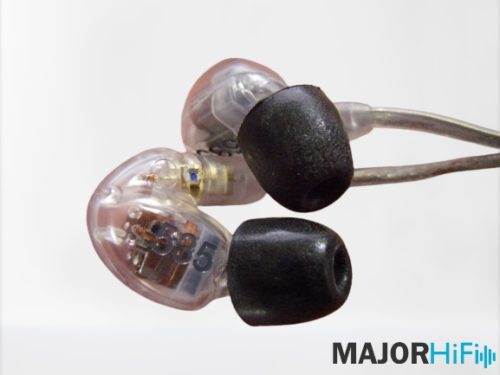
Comfort – Decent comfort, kind of difficult to put on.
Durability – Strong feel, the buds themselves made of hard plastic. Wire seems somewhat brittle.
Soundstage – Wide enough to fit everything, still a little narrow, which is perfect for drumming. It keeps focus.
Lows – Well defined, not overpowering, with consistent response
Mids – Flat, does not cause any muddying, allowing maximum clarity from instrument to instrument.
Highs – The constant clashing cymbals is a walk in the park. At high volumes, the highs develop a brightness about them in the upper highs, while maintaining the flatness towards the high-mids that makes it ideal for this application. All the sound, no loss of clarity.
Replaceable components – Highly. Shure is known for compatibility across models too, so if you’re looking to upgrade or even downgrade, you’ll be able to use the same products.
Shure is probably at the forefront of drumming in-ears. It’s easy to hear why when you take a listen. The flat and narrow response across the board says one thing: it means business. Literally. You definitely won’t be listening for fun on these, which kind of tells you who they’re made for (you).
SHURE SE425
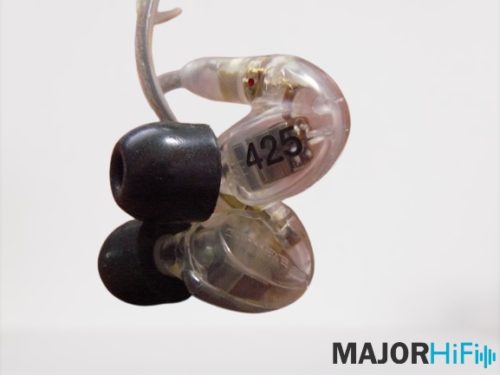
Comfort – Sits snug in the ear
Durability – Same hard plastic and seemingly-brittle wire. Luckily, Shure’s wires sit on the cheaper side for replacement.
Soundstage – Good amounts of width and depth
Lows – Not as pronounced, falls behind the other ranges sometimes.
Mids – A little bit more accentuated, blending the ranges in a way that was nice for listening, could impact clarity while playing though.
Highs – Consistently bright, accurate transients that allow for an easily distinguishable range. However, I could see this brightness becoming a distraction, though you may not. A little more flatness would make these flawless.
Replaceable components – Highly, as is with just about all Shure IEMs.
They are pretty similar to their more expensive counterpart. Key differences are the width, mids and highs. These are a tad bit wider, the mids are a boosted a little more, and the highs were brighter.
FINAL AUDIO A4000
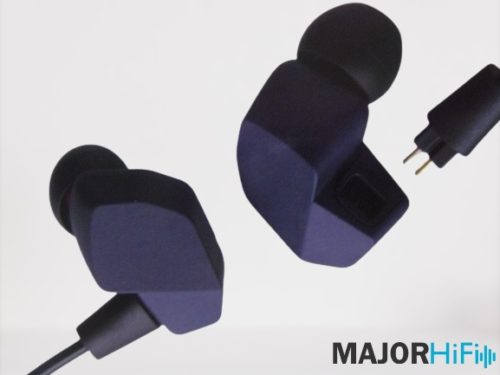
Comfort – Sits nicely in the ear, a little heavy but fits surprisingly snug.
Durability – Very solid body and wire
Soundstage – Very wide
Lows – Solid, well balanced
Mids – A tiny bit more than one would like, but I don’t see it getting in the way.
Highs – Shimmery and clear, minimal brightness and sharpness for more accurate sound.
Replaceable components – yes, but pricey.
Slightly more geared towards listening, but the A4000’s could be used for either, and with high quality and clarity. These are applicable if you like a little more involvement in your monitoring – if you want to hear more detail in your mix, these are a prime option.
Sennheiser IE300

Comfort – Very comfortable
Durability – Sturdy build
Soundstage – Good amounts of width and depth
Lows – Full, great definition
Mids – Pretty neutral in defining each piece, does so with immense clarity
Highs – Snappy, clear highs that avoid brightness, allowing for long periods of play
Replaceable components – Yes
Also geared towards listening, but could very well be utilized in this application. In line with the A4000’s, the Sennheiser IE300 offer a more detailed listening experience to the mix, and if you’re looking to be immersed in the music as much as you are involved in creating it, then these are a perfect fit.
CONCLUSION
Sound is almost entirely subjective. What’s bad to me might be gold to you, and vice versa. Therefore, you could use the headphones that came with your phone if you really wanted (though I don’t recommend that) – at the end of the day, you’re trying to figure out exactly what YOU want and need, and that could vary from person to person, from headphone to headphone. I urge you to try them out before purchase if you can. If you can’t, then that’s exactly why we made this list.
Drums are the backbone of music. Period. That’s why it is essential that our drummers hear what they need to, as to maximize not only their performance, but the band as a whole.
I hope this list of the Top 5 In-Ears for Drummers has helped you find what you need.
For more in depth reviews on these headphones, check out our site for more info.
MAJORHIFI may receive commissions from retail offers.


